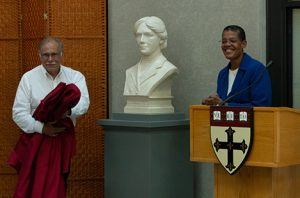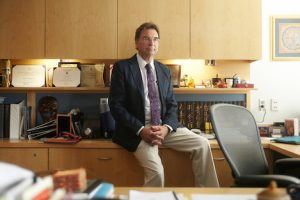Harvard Chan School’s Education and Research Center for Occupational Health and Safety carries on legacy of pioneer Alice Hamilton
January 9, 2019—When Alice Hamilton joined Harvard’s faculty in 1919, workplace hazards were plentiful. American manufacturing was on the rise and across the country scores of workers were regularly exposed to myriad toxins, including lead, mercury, and asbestos to name just a few.
Hamilton knew the risks workers faced perhaps better than anyone at the time. Prior to coming to Boston, she had spent decades studying the health of people laboring in the lead and enamelware industries, as well as rubber production and explosives production. Combining relentless investigative field work with data-driven epidemiological analyses, Hamilton laid the foundation for the then nascent field of occupational health. Her research and advocacy helped shape state and federal policies aimed at safeguarding workers, including the landmark Occupational Safety and Health Act of 1970, which was signed by President Richard Nixon three months after Hamilton died at the age of 101.
Today—100 years after she joined Harvard—Hamilton’s influence can be seen across Harvard T.H Chan School of Public Health.

“Her work gave rise to three differentiated specialties within the field of occupational health and safety: occupational medicine, industrial toxicology, and industrial hygiene, now called occupational hygiene,” said David Christiani, Elkan Blout Professor of Environmental Genetics. “And we’ve made tremendous progress in each of those areas.”
Christiani heads up Harvard Chan School’s Education and Research Center (ERC) for Occupational Health and Safety, which was first established in 1977 and recently secured a five-year, $8.5 million grant from the National Institute for Occupational Safety and Health. The funding will go a long way toward training professionals in various disciplines to identify and tackle health risks that are affecting today’s workforce.
The Center runs a residency training and education program for physicians who seek to become Board-eligible in Occupational and Environmental Medicine. In addition, it offers doctoral education in epidemiology, hygiene, and interdisciplinary training, as well as Master’s degrees in occupational hygiene and occupational/environmental health. Moreover, the ERC funds pilot projects in research training, and it regularly supports the School’s Executive and Continuing Professional Education program in offering continuing education trainings and workshops for physicians, nurses, industrial hygienists, and others about occupational safety and health. Finally, the ERC has an active outreach program that promotes research translation to industry, unions, and policy makers, among other stakeholders. In many ways, Christiani said, the Center’s efforts are a direct extension of Hamilton’s legacy.
While significant progress has been made toward protecting workers in the U.S. since Hamilton’s heyday, countless risks still loom and new ones emerge seemingly every year given the rapid proliferation of new chemicals and technologies. “There are exposures today that Alice had no idea would come along,” Christiani said. For instance, his work has examined particulate matter and compounds such as chromium used in welding, and indium tin oxide, used to make computer screens, both of which may increase the risk of certain cancers. Then there’s phthalates, a group of chemicals used in the production of plastics that can mimic certain human hormones when introduced into the body and cause chronic health problems.

As the U.S. economy has evolved away from mines and textile factories in favor of office parks and cubicles, other types of occupational risks have come to prominence, including repetitive strain injuries such as carpal tunnel syndrome and back pain, as well as increased rates of sinusitis and other upper airway syndromes associated with air-conditioned office spaces. Occupational asthma is now the most common workplace respiratory disorder, supplanting silicosis and asbestosis. These types of injuries may be less dramatic than the deadly lead and mercury poisonings of Hamilton’s era, but Christiani said they have a significant impact on morbidity and cost billions of dollars a year in lost productivity and health care expenses.
“Ergonomic issues such as back and spinal disorders have exploded in the modern workplace,” he said. “Carpal tunnel syndrome is estimated to cost more than $2 billion a year in the U.S. alone.” He also noted that many of the toxic industries and exposures that Hamilton encountered have been shipped overseas to developing countries, where regulations tend to be more lax.
Christiani said that the ERC strives to give students and other trainees a well-rounded education to prepare them for the challenges facing workers and employers. Some students have gone on to work for government agencies tasked with ensuring that workplaces are in compliance with regulatory standards. Others have gone into the private sector as consultants to help companies optimize their practices when it comes to occupational health. The ERC also trains occupational epidemiologists to analyze trends and risks, which is critical to understanding and ultimately mitigating the impact of disease and injury from workplace exposures.
As occupational health continues to grow in prominence, Christiani said he expects that demand for those with expertise in the field will only grow. The so-called “silver tsunami” of retiring Baby Boomers along with more stringent regulations have led to increased demand for people who have training and experience in occupational medicine, occupational hygiene, and promoting health in the workplace.
“I believe Alice would have been pleased to see the growth of an entire workforce devoted to ensuring the safety and health of employees,” Christiani said.
Photos: istock.com/Nilagia McCoy/Kent Dayton
